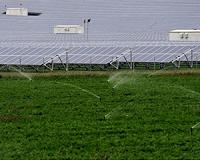 |
Copenhagen, Denmark (SPX) Nov 15, 2010 New ultra-clean nanowires produced at the Nano-Science Center, University of Copenhagen will have a central role in the development of new high-efficiency solar cells and electronics on a nanometer scale. PhD student Peter Krogstrup, Niels Bohr Institute, in collaboration with a number of well-known researchers and the company SunFlake A/S, is behind the breakthrough. The new findings have recently been published in the prestigious journal Nano Letters. Nanowires are one-dimensional structures with unique electrical and optical properties - a kind of building blocks, which researchers use to create nanoscale devices. In recent years, there has been a great deal of research into how nanowires can be used as building blocks in the development of solar cells. One of the challenges is controlling the production of nanowires. The new ultra-clean nanowires are part of the solution. Ultra clean means that the electronic structure is perfectly uniform throughout the nanowires, which is a very important part in obtaining nano-electronic devices of high performance. This is achieved by growing the wires without the use of a metal catalysis like gold, and at the same time having a perfect crystal of only one single structural phase which until now have been impossible for these types of nanowires. The ultra-clean wires are grown on a silicon substrate with an extremely thin layer of natural oxide. The element Gallium, which is a part of the nanowire material, reacts with the oxide and makes small holes in the oxide layer, and here the gallium collects into small droplets of a few nanometers in thickness. These droplets capture the element Arsenic - the other material in the nanowire and through a self-catalytic effect starts the growth of the nanowires without interference from other substances, explains Peter Krogstrup. The breakthrough is the result of a year's work in connection with his PhD.
Control over the cultivation of nanowires A nanowire normally consists of both hexagonal and cubic crystal segments, but the new nanowires only consist of a perfect cubic crystal structure. This means that the path of the electrons through the wire is unaffected and thus suffers less energy loss which leads to a higher efficiency. + This better understanding of the growing process gives us control over the cultivation of nanowires and the clean wires are the starting point for my current work developing a high efficiency solar cell based on nanowires. With these results we are a good step closer to this goal, explains Peter Krogstrup, pointing out that his nanowires are grown on a silicon substrate. The substrate is cheaper than the alternative substrates that many other researchers use. It is important because ultimately it is about getting as much energy as possible for as little cost as possible, explains Peter Krogstrup, whose research is conducted in collaboration with the company SunFlake A/S, which is located at the Nano-Science Center at the University of Copenhagen. The company is working to develop the solar cells of the future based on the nanostructures of Gallium and Arsenic.
Share This Article With Planet Earth
Related Links University of Copenhagen All About Solar Energy at SolarDaily.com
 In Greece's fallow fields, solar energy stirs
In Greece's fallow fields, solar energy stirsAsopia, Greece (AFP) Nov 14, 2010 The son and grandson of farmers, Spyros Papathanassiou spends most of the day overseeing his family olive press and winery in the outskirts of Asopia, a village northeast of Athens. But his future is invested in a fenced-off contraption in the hills outside the village - a 5,800-square-metre solar farm on which Papathanassiou sank nearly half a million euros (dollars) three years ago. " ... read more |
|
| The content herein, unless otherwise known to be public domain, are Copyright 1995-2010 - SpaceDaily. AFP and UPI Wire Stories are copyright Agence France-Presse and United Press International. ESA Portal Reports are copyright European Space Agency. All NASA sourced material is public domain. Additional copyrights may apply in whole or part to other bona fide parties. Advertising does not imply endorsement,agreement or approval of any opinions, statements or information provided by SpaceDaily on any Web page published or hosted by SpaceDaily. Privacy Statement |